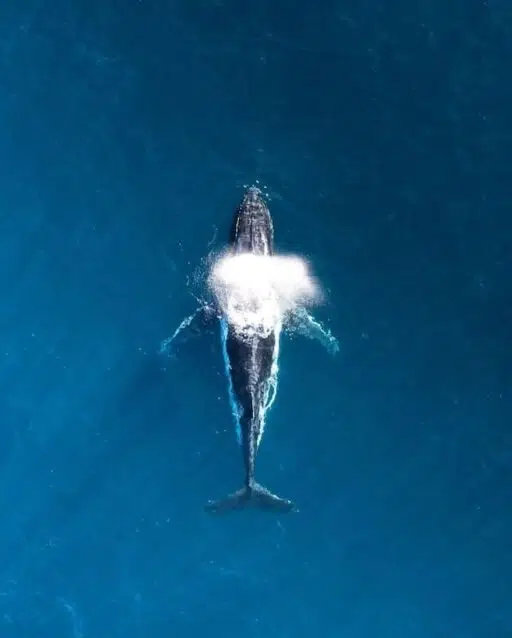Being the absolute biggest animal on our planet, easily beating the other contenders in our list of the top 10 biggest animals in the world, whales demand our respect. It isn’t easy to comprehend just how breathtakingly giant these creatures are. But whales are not only the biggest animal; they are tragically also one of the most endangered animals.
Whales are one of the most important members of marine life. Also, they exist in plenty of species and each species has some specification or exclusive feature.
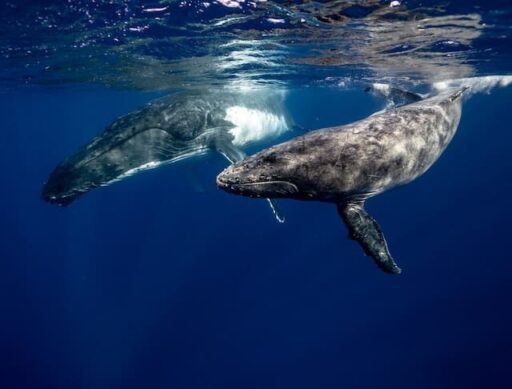
Over the past century, many species of whales have gone through extreme population loss. Some species only have a few individuals left. There are multiple factors that are contributing to their population decline.
This article explores the 11 most endangered whales and thoroughly discusses the key factors of their endangerment.
Key points
| Whale Species | Scientific Name | Population Estimate | Main Threats |
|---|---|---|---|
| North Atlantic Right Whale | Eubalaena Glacialis | <500 individuals | Entanglement in fishing gear, ship collisions |
| North Pacific Right Whale | Eubalaena japonica | <1000 individuals | Ship collisions, climate change, noise and pollution |
| Sei Whale | Balaenoptera borealis | Less than 1/3 of 1950s population | Habitat loss, ship strikes |
| Blue Whale | Balaenoptera musculus | 1000-2000 individuals | Habitat loss, ship strikes |
| Western Gray Whale | Eschrichtius robustus | 103 individuals | Entanglement in fishing gear, ship collisions, oil and gas development |
| Sperm Whale | Physeter macrocephalus | Declining population | Historical whaling, habitat degradation |
| Fin Whale | Balaenoptera physalus | Endangered | Historical whaling, ship strikes, entanglement in fishing gear, noise and pollution |
| Bowhead Whale | Balaena mysticetus | Critically endangered | Historical whaling, climate change, ship strikes, pollution |
| Humpback Whale | Megaptera novaeangliae | Declining population | Commercial whaling, entanglement in fishing gear, vessel strikes, vessel-based harassment |
| Beluga Whale | Delphinapterus leucas | Declining population | Ship collisions, pollution |
| Narwhal Whale | Monodon monoceros | Declining population | Ivory tusk hunting, ship collisions, climate change |
#1 North Atlantic Right Whale
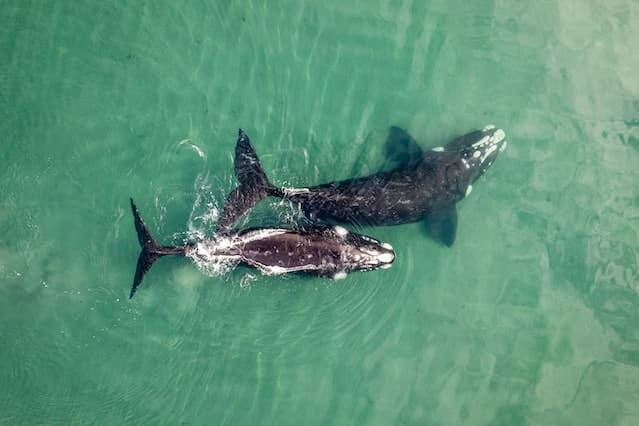
| Statistic | Value |
|---|---|
| Scientific Name | Eubalaena glacialis |
| Family | Balaenidae |
| Average Length | 13 – 18 meters (43 – 59 feet) |
| Average Weight | 40 – 70 tons (36,000 – 63,500 kg) |
| Lifespan | Up to 70 years |
| Population Status | Endangered |
| Population Size | Approximately 360 individuals (as of 2021) |
| Habitat | North Atlantic Ocean |
| Range | From southern U.S. to eastern Canada |
| Diet | Filter feeder (krill, copepods, zooplankton) |
| Conservation Status | Endangered |
| Threats | Entanglement in fishing gear, vessel strikes, habitat degradation, climate change |
One of the most critically endangered whale species is the North Atlantic Right Whale. They are scientifically known as Eubalaena Glacialis and have suffered the greatest population declines. This particular type of whale was considered ideal for commercial whaling back in the 18th and 19th centuries.
Being the most targeted whale by the whalers, the species was named right whales – the right whales to hunt. The reason why hunters named them the right whales was due to them being super convenient to hunt. This is so because of their swimming habits.
They like to swim near the sea shores and start floating on the surface of the water once killed, which makes capturing them easy.
According to a rough estimation the North Atlantic Right Whale’s population currently consist of less than 500 individuals, a number which is reducing further day by day. Following this scenario, the IUCN has enlisted North Atlantic Right Whale as a critically endangered whale.
Naturally it is strictly banned to hunt these critically endangered whales. However, their existence is still threatened by humans due to entanglement in fishing gear and ship collisions.
#2 North Pacific Right Whale
| Statistic | Value |
|---|---|
| Scientific Name | Eubalaena japonica |
| Family | Balaenidae |
| Average Length | 14 – 18 meters (46 – 59 feet) |
| Average Weight | 50 – 80 tons (45,000 – 72,500 kg) |
| Lifespan | Up to 100 years |
| Population Status | Endangered |
| Population Size | Approximately 30 – 100 individuals (as of 2021) |
| Habitat | North Pacific Ocean |
| Range | Primarily in the eastern and western North Pacific |
| Diet | Filter feeder (krill, copepods, zooplankton) |
| Conservation Status | Endangered |
| Threats | Historical whaling, entanglement in fishing gear, vessel strikes, habitat degradation, climate change |
Similar to the North Atlantic right whale, the North Pacific right whale was also excessively targeted by whale hunters. According to one survey report, whale hunters killed around 26,500 to 37,000 North Pacific right whales in the late 19th century. Besides, their exact population before poaching was pursued is unknown to the world.
As per the constant decline in their population, they have been listed as endangered under the Endangered Species Act since 1970. By now, their global population consists of less than 1000 individuals. Moreover, the species has almost become extinct in the Northeastern Pacific Ocean around Alaska. Thankfully, the Marine Mammal Protection Act also provides them with protection.
Please note that commercial whaling is no longer a threat to the North Pacific right whale as this activity is already banned by the respective authorities.
However, humans still pose threats in many different ways. For example, ship collisions is the one main reason for the drastic downfall of their population.
Another reason for their depletion is climate change, which is causing their habitats to disintegrate. Additionally, noise and pollution are also prone to threaten the survival of this species globally.
Therefore, the IUCN has enlisted North Pacific right whales as a critically endangered whale species.
#3 Sei Whale
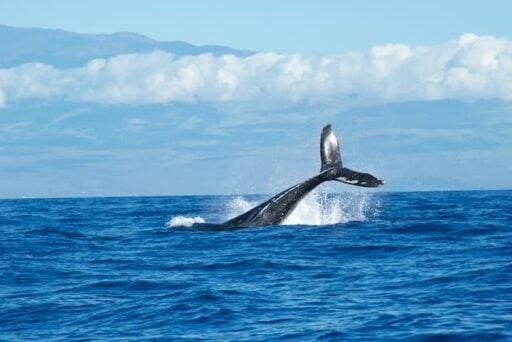
| Statistic | Value |
|---|---|
| Scientific Name | Balaenoptera borealis |
| Family | Balaenopteridae |
| Average Length | 14 – 18 meters (46 – 59 feet) |
| Average Weight | 20 – 30 tons (18,000 – 27,000 kg) |
| Lifespan | Up to 70 years |
| Population Status | Endangered |
| Population Size | Approximately 8,000 – 12,000 individuals (as of 2021) |
| Habitat | Oceans worldwide, primarily in temperate and subpolar regions |
| Range | Found in all major oceans |
| Diet | Krill, copepods, small fish |
| Conservation Status | Endangered |
| Threats | Historical whaling, habitat degradation, climate change, entanglement in fishing gear, underwater noise pollution |
The sei whale, scientifically known as Balaenoptera Borealis, is one of the fastest whales that can easily inhabit every ocean on earth.
Sei whales are comparatively thinner and less blubbery than other baleen whales, which is why they were only hunted from the early 20th century and onwards.
However, the over-exploitation of other baleen whales resulted in a shortage of whales to hunt. Subsequently, hunters started targeting sei whales for commercial whaling.
The commercial whaling of sei whales became more common during the 1950s to the 1980s. There was constant hunting for three decades, which naturally lead to a severe decline in their population.
Experts believe that the current population of sei whales is less than one-third of the population in the 1950s. Due to this, the IUCN has deemed sei whales endangered. Although, their hunting is banned, still, there are many threats to their survival.
#4 Blue Whale
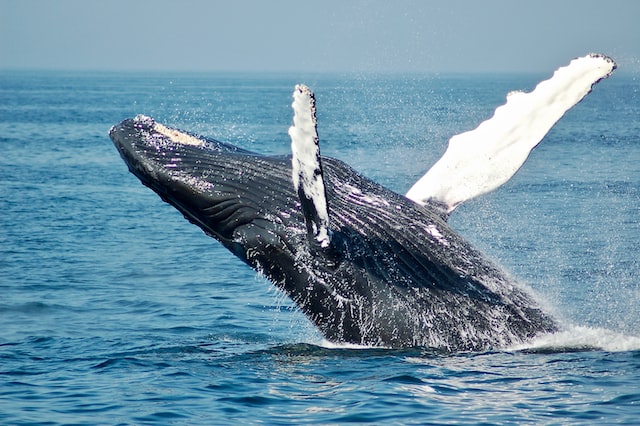
| Statistic | Value |
|---|---|
| Scientific Name | Balaenoptera musculus |
| Family | Balaenopteridae |
| Average Length | 24 – 30 meters (79 – 98 feet) |
| Average Weight | 100 – 150 tons (90,000 – 136,000 kg) |
| Lifespan | Up to 90 years |
| Population Status | Endangered |
| Population Size | Approximately 10,000 – 25,000 individuals (as of 2021) |
| Habitat | Oceans worldwide |
| Range | Found in all major oceans |
| Diet | Krill, small fish |
| Conservation Status | Endangered |
| Threats | Historical whaling, ship strikes, entanglement in fishing gear, habitat degradation, climate change |
The blue whale is a type of baleen whale – the largest animal existing on the planet Earth. Sadly, the world will soon lose this wondrous marine mammal as it is one of the most endangered whales.
Being the largest animal on the planet, a blue whale’s weight can exceed 200 tons which is approximately equal to the weight of around 33 elephants.
Experts have asserted that the size of a blue whale’s heart is equivalent to the size of a Volkswagen Beetle. Moreover, its usually consumes as much as four tons of krill everyday as its stomach is able to hold several tons of krill.
In addition, they are the most vocal and loudest animals – their sound being even louder than a jet engine. But, there are only 1000 to 2000 species of blue whales left in the world. Plus, research predicts their population to decrease further in the coming years due to habitat loss and ship strikes.
Fortunately, there are still some areas where you can witness these disappearing creatures; you can explore further by reading our article on the top places to see blue whales.
#5 Western Gray Whale
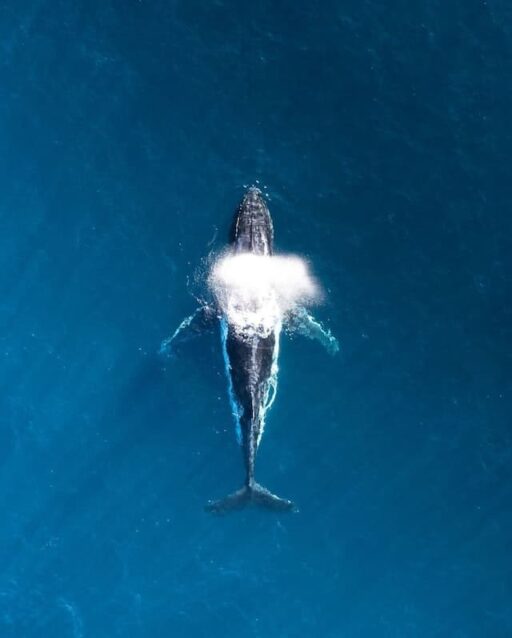
| Statistic | Value |
|---|---|
| Scientific Name | Eschrichtius robustus |
| Family | Eschrichtiidae |
| Average Length | 12 – 16 meters (39 – 52 feet) |
| Average Weight | 15 – 35 tons (13,600 – 31,800 kg) |
| Lifespan | Up to 70 years |
| Population Status | Least Concern |
| Population Size | Approximately 20,000 – 27,000 individuals (as of 2021) |
| Habitat | Eastern and western North Pacific, nearshore and coastal waters |
| Range | North Pacific Ocean |
| Diet | Benthic invertebrates (such as amphipods and small crustaceans) |
| Conservation Status | Least Concern |
| Threats | Historical whaling (population recovery), habitat degradation, entanglement in fishing gear |
Western gray whales, scientifically known as Eschrichtius robustus, has many other names: the gray back whale, Pacific gray whale, Korean gray whale, or California gray whale. It is another unique type of baleen whale marked as a critically endangered whale.
The average lifespan of gray whales ranges from 75 years to 80 years. Also, it is often called the gray whale due to having various gray patches on its body.
Sadly, this beautiful species of whales is on the verge of becoming extinct as only 103 gray whales are left on the planet. The major reasons for their population decrease are entanglement in fishing gear, ship collisions, and oil and gas development.
Fortunately, there are still some areas where you can witness these disappearing creatures; you can explore further by reading our article on the top places to see gray whales.
#6 Sperm Whale
| Statistic | Value |
|---|---|
| Scientific Name | Physeter macrocephalus |
| Family | Physeteridae |
| Average Length | Males: 16 – 20 meters (52 – 66 feet) <br> Females: 11 – 13 meters (36 – 43 feet) |
| Average Weight | Males: 45 – 60 tons (40,800 – 54,400 kg) <br> Females: 14 – 18 tons (12,700 – 16,300 kg) |
| Lifespan | Up to 70 years |
| Population Status | Vulnerable |
| Population Size | Approximately 200,000 – 250,000 individuals (as of 2021) |
| Habitat | Oceans worldwide |
| Range | Found in all major oceans, primarily deep waters |
| Diet | Mainly squid, also fish and other cephalopods |
| Conservation Status | Vulnerable |
| Threats | Historical whaling, habitat degradation, entanglement in fishing gear, underwater noise pollution |
Sperm whales are also known as cachalot. They are the largest type of toothed whales which makes them incredibly great predators. Sperm whales belong to the genus Physeter.
The average lifespan of spam whales can reach up to 70 years. However, they have been the prime target of the whaling industry which is why their population is suffering from a continuous decrease. Viewing that, the relevant authorities have added them to the red list of the most endangered whales.
Fortunately, there are still some areas where you can witness these disappearing creatures; you can explore further by reading our article on the top places to see Sperm whales. If you want some exciting news pertaining to Sperm whales, read our article on a fierce battle between a sperm whale and giant squid.
#7 Fin Whale
| Statistic | Value |
|---|---|
| Scientific Name | Balaenoptera physalus |
| Family | Balaenopteridae |
| Average Length | 20 – 26 meters (66 – 85 feet) |
| Average Weight | 40 – 80 tons (36,000 – 72,000 kg) |
| Lifespan | Up to 90 years |
| Population Status | Endangered |
| Population Size | Approximately 50,000 – 90,000 individuals (as of 2021) |
| Habitat | Oceans worldwide, primarily in deep and offshore waters |
| Range | Found in all major oceans, with higher concentrations in colder waters |
| Diet | Krill, small fish, and squid |
| Conservation Status | Endangered |
| Threats | Historical whaling, ship strikes, entanglement in fishing gear, habitat degradation, underwater noise pollution |
The fin whale, scientifically known as Balaenoptera physalus, is the second-largest whale on the planet. They are named fin whales due to their hooked dorsal fin on their back. The fin compromises around two-thirds of the body. Moreover, they have a sleek and streamlined body that carries a v-shaped head.
The distinctive coloration is another unique feature of fin whales: their body is black or dark brownish-gray on the back and sides, and white on the underside. However, these beautiful whales are soon going extinct.
Their population first started declining back in the late 1900s when the commercial whaling of fin whales was quite common.
Subsequently, fin whales were considered endangered under the Endangered Species Conservation Act, and the Endangered Species Act (ESA), since 1970. In addition, fin whales are now listed as endangered under the Marine Mammal Protection Act, too.
Fortunately, there are still some areas where you can witness these disappearing creatures; you can explore further by reading our article on the top places to see Fin whales.
#8 Bowhead Whales
| Statistic | Value |
|---|---|
| Scientific Name | Balaena mysticetus |
| Family | Balaenidae |
| Average Length | 14 – 18 meters (46 – 59 feet) |
| Average Weight | 75 – 100 tons (68,000 – 90,700 kg) |
| Lifespan | Up to 200 years |
| Population Status | Least Concern |
| Population Size | Approximately 10,000 – 12,000 individuals (as of 2021) |
| Habitat | Arctic and subarctic regions |
| Range | Arctic Ocean and adjacent seas |
| Diet | Zooplankton, small fish, and benthic organisms |
| Conservation Status | Least Concern |
| Threats | Historical whaling (population recovery), climate change, habitat degradation |
Bowheads, scientifically known as Balaena Mysticetus, are thought to be the oldest mammals on our planet as they have the largest lifespan, reaching well over 100 years. In addition, this unique specie of whales has the ability to live in icy waters.
But sadly, this oldest mammal is nearing extinction as the species is already enlisted as critically endangered. The leading factor contributing to their endangerment is commercial whaling.
Please note that the bowhead whales have been largely used for commercial whaling since the early 1800s. Although the commercial whaling of bowheads was banned in 1921, it continued till the mid-1900s.
Due to this constant whaling that lasted for more than a century, their population declined to less than 3000 whales back in 1921.
The prime reason for their whaling was the economic value of their oil and baleen. Also, bowheads tend to float on the water once killed, which makes hunting this previous species very convenient for hunters.
Despite bowhead’s commercial whaling was banned in 1921 already, their population is constantly decreasing. This is due to food deprivation, vessel strikes, pollution, sea predators, and climate change.
Viewing their constant population decline, bowhead whales are listed as endangered under the Endangered Species Act in 1971. Moreover, it is recognized as endangered under the Marine Mammal Protection Act.
#9 Humpback Whales
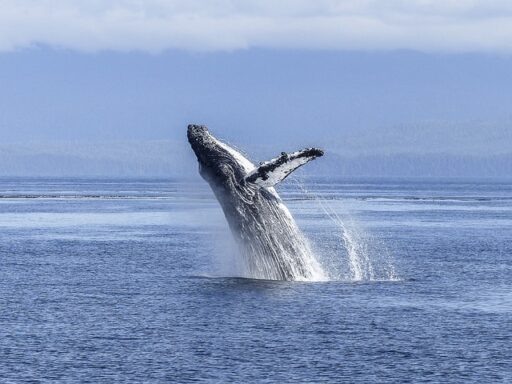
| Statistic | Value |
|---|---|
| Scientific Name | Megaptera novaeangliae |
| Family | Balaenopteridae |
| Average Length | 12 – 16 meters (39 – 52 feet) |
| Average Weight | 25 – 40 tons (22,700 – 36,300 kg) |
| Lifespan | Up to 50 years |
| Population Status | Least Concern |
| Population Size | Approximately 80,000 individuals (as of 2021) |
| Habitat | Oceans worldwide, nearshore and coastal waters |
| Range | Found in all major oceans, migrating between polar and tropical waters |
| Diet | Krill, small fish, and plankton |
| Conservation Status | Least Concern |
| Threats | Historical whaling (population recovery), entanglement in fishing gear, habitat degradation, underwater noise pollution |
The humpback whale is another critically endangered species of baleen whales.
Humpback whales are rorqual and belong to the family Balaenopteridae. The average lifespan of humpback whales ranges from 45 to 50 years. Moreover, these types of whales have a very distinctive body shape, especially their long pectoral fins and knobbly head.
There is no specific habitat of humpbacks as they can live in any ocean in the world. However, their population have been suffering a serious decline for the past few decades, which is why there are only a few individuals left on earth. The primary threat to their existence is human activities that may include commercial whaling, entanglement in fishing gear, vessel strikes, and vessel-based harassment.
Fortunately, there are still some areas where you can witness these endagered creatures; you can explore further by reading our article on the top places to see Humpback whales.
#10 Beluga Whales
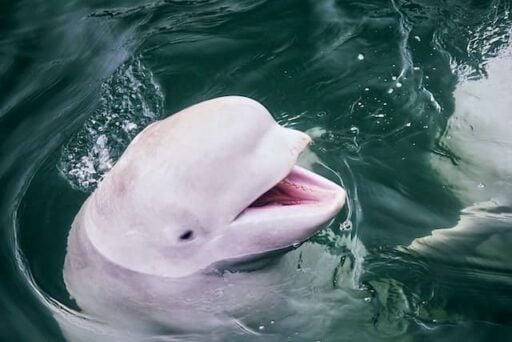
| Statistic | Value |
|---|---|
| Scientific Name | Delphinapterus leucas |
| Family | Monodontidae |
| Average Length | 3 – 5 meters (10 – 16 feet) |
| Average Weight | 1 – 1.5 tons (900 – 1,360 kg) |
| Lifespan | Up to 50 years |
| Population Status | Near Threatened |
| Population Size | Approximately 150,000 – 170,000 individuals (as of 2021) |
| Habitat | Arctic and subarctic coastal waters |
| Range | Northern regions of the Atlantic and Pacific Oceans |
| Diet | Fish, squid, shrimp, and other marine invertebrates |
| Conservation Status | Near Threatened |
| Threats | Climate change, habitat degradation, pollution, disturbance, hunting |
Beluga whales is another distinctive species of whales whose extinction is predicted in the next few years.
Beluga whales are also known as White Whales. Their speciality is their unusual color which makes them the most unique species of whales.
Another distinctive feature of Belugas is their social behavior. Talking about their social behavior, it’s important to mention their nickname which is chirrups as they are extremely vocal.
Interestingly, they use the unique language of certain clicks, clangs, and whistles for communication.
Sadly, this unique species of toothed whales is soon to be on the verge of extinction. Luckily though, their population in the United States remains stable. However, ship collisions are pinned as the main reason for their endangerment in other regions of the world.
Explore the Beluga Whale in more depth with our article all about this white whale!
#11 Narwhal Whales
| Statistic | Value |
|---|---|
| Scientific Name | Monodon monoceros |
| Family | Monodontidae |
| Average Length | Males: 4 – 5 meters (13 – 16 feet) <br> Females: 3 – 4 meters (10 – 13 feet) |
| Average Weight | Males: 1,600 – 1,800 kg (3,500 – 4,000 lbs) <br> Females: 900 – 1,600 kg (2,000 – 3,500 lbs) |
| Lifespan | Up to 50 years |
| Population Status | Near Threatened |
| Population Size | Approximately 50,000 – 80,000 individuals (as of 2021) |
| Habitat | Arctic and subarctic coastal waters, sea ice |
| Range | Arctic regions, primarily in Canada, Greenland, and Russia |
| Diet | Fish (cod, Greenland halibut), squid, shrimp, and other marine invertebrates |
| Conservation Status | Near Threatened |
| Threats | Climate change, habitat degradation, noise pollution, hunting |
Narwhales are the most fascinating species of whales with long ivory tusks that protrude from their heads. Unfortunately, the world will soon face the extinction of this unique whales species.
Due to their deeply fascinating look, Narwhals are also regarded as the unicorns of the sea. They are medium-sized toothed whales that go through a distinctive color diversification throughout their lifetime. Narwhals’ color diversification is their added exciting feature.
Specifically, their color changes as they age. Born in blue-gray color, they become blue-black as juveniles, mottled gray as adults, and finally turns all-white once they are old. Surveys suggest that only three breeds of Narwhals are left in the Arctic which used to be their main hub.
There are a few factors that are contributing to the endangerment of this sea unicorn. Among these factors, the hunt for narwhals is the most pressing reason. Hunters hunt narwhals to sell their long ivory tusks. In addition, ship collisions and the fluctuation in the sea levels, or climate change, have also contributed to the endangerment of these toothed whales.
Final Words
Our whales are incredibly important to the ocean’s ecosystems. If they reach extinction it will send shock waves throughout the world’s seas and affect all marine life.
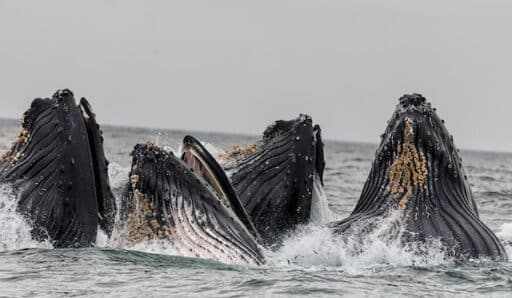
Although whales are so much bigger than us humans they are still in urgent need of our assistance. Since they’re mammals we share a significant amount of DNA with them, of course we must help our distant cousins! It is vital that we raise awareness about their precarious position and support marine conservation programmes.
Thank you for reading this article! If you still crave more knowledge about the species inhabiting our oceans you should take a look at the Top 10 Dangerous Marine Animals.
Frequently Asked Questions (FAQs)
Q: Why are whales endangered?
A: Whales are endangered primarily due to historical whaling practices, which significantly reduced their populations. Other factors contributing to their endangerment include habitat degradation, climate change, pollution, entanglement in fishing gear, underwater noise pollution, and collisions with ships.
Q: How are endangered whales protected?
A: Endangered whales are protected through various conservation measures. These include international agreements such as the International Whaling Commission’s moratorium on commercial whaling, regulations on hunting and fishing practices, establishment of protected areas, monitoring and research initiatives, and public awareness campaigns to promote whale conservation.
Q: What is the main threat to endangered whales today?
A: The main threats to endangered whales today include habitat degradation and loss, entanglement in fishing gear (known as bycatch), underwater noise pollution from human activities such as shipping and oil exploration, climate change impacts on their food sources, and pollution (such as marine debris and chemical contaminants) affecting their health.
Q: Are all whale species endangered? A: Not all whale species are endangered. However, many species are classified under various conservation statuses, ranging from least concern to critically endangered.
Q: How can individuals help protect endangered whales?
A: Individuals can contribute to whale conservation efforts by supporting organizations working to protect whales, participating in beach clean-ups to reduce marine pollution, promoting responsible whale watching practices, reducing plastic usage to prevent marine debris, supporting sustainable seafood choices, and raising awareness about the importance of whale conservation within their communities.
Q: Are there efforts to recover endangered whale populations?
A: Yes, there are ongoing efforts to recover endangered whale populations. These efforts involve habitat conservation, reducing threats such as entanglement in fishing gear and ship strikes, implementing regulations and policies to protect whales, conducting research to understand their behavior and population dynamics, and collaborating on international conservation initiatives.
Q: Can ecotourism benefit endangered whales?
A: Ecotourism can benefit endangered whales if conducted responsibly and with proper regulations in place. Well-managed whale watching activities can provide economic incentives for conservation, raise awareness about the importance of protecting whales and their habitats, and promote sustainable practices that minimize disturbance to the animals.
Q: How can climate change impact endangered whales?
A: Climate change can impact endangered whales in various ways. It can alter their oceanic habitats by affecting water temperature, sea ice patterns, and the distribution of their prey species. Climate change can also contribute to sea-level rise, ocean acidification, and changes in ocean currents, which can disrupt their feeding and migration patterns, and ultimately impact their survival and reproductive success.
Join our Forum for free today!


